Key Business Issues and the Impact of Various Factors
Main Problems of Business Development
One of the most significant problems hindering the development of any business is the political situation within the state. Entrepreneurs tend to be dissatisfied with the complex bureaucratic system, the taxation system associated with unreasonably high taxes, regulatory agencies and high levels of corruption. The second problem in the way of business development is financial policy. Even if a business grows, profit increases monthly and there is no staff turnover, it does not mean that everything is stable and will always be so.
It is assumed that the most optimal national economic programme is the creation of flexible and dynamic markets of labour, goods and capital able to quickly and effectively adapt to the changing environment, reflected in the profitability and competitiveness of enterprises. No one is immune to such risks as a new player with more attractive prices or an expanded offer appearing in the market. As can be seen from this, some business projects are unable to withstand competition or financial oppression as a result of, for example, wrong management strategies or income distribution. The result is that an entrepreneur has two development scenarios left – losing an economic race or reconsidering business and possibly switching to a group of goods with higher margins.
A large pool of problems may be related to the technical difficulties of the enterprise. Lack of necessary equipment or its regular breakdown steer the business off its course, and as a result, there is a regression. The solution to such a problem can be hidden in maximising the alignment of business processes, including internal and external ones. A big problem of modern business is also the socio-psychological policy of management. Today, increasingly more international companies are adopting a D&I programme that defines diversity and involvement of employees in corporate culture.
The Company for this Assignment
The company that is investigated as an example for this purpose refers to the oil and gas industry. As it is known, the world economy directly depends on the volume of oil and gas production, as well as the ability to process them into high-quality fuel.
Companies that work in this area, including those related to this field, have a large scale of production and a large staff. A large department of the Saudi Aramco is connected with HR activities because such a number of employees should be coordinated. HR managers are the critical link between employees and management department. The work of this department includes the organisation of training and development of employees, participation in operational management and solution of current issues, as well as improvement of corporate culture, working conditions and analysis of HR policy efficiency.
Factors that Define the HR Function of a Business
A competent personnel policy of the organisation, which considers the internal and external factors affecting it, will allow the preservation of the competitiveness of the organisation and ensure the high quality of its staff. Considering the factors influencing the HR policy will help to align the economic benefit, which is the goal of the employer, and the needs of employees, increasing their motivation and involvement.
Political Influence
The political picture within the state or on the international scene plays a vital role in the existence of the business. The introduction of new laws restricting the functions of small and medium-sized companies hurts the development of the company. Power is a mechanism that regulates companies in both positive and negative contexts. On the other hand, however, politics is often seen as a derivative business, as big business is involved in political games.
Economic Influence
The economic policy of the states in the sphere of business management has a significant influence. The state of the world economy affects the cost of all inputs and the ability of consumers to buy certain goods and services. If, for example, inflation is projected, management may consider it desirable to increase the inventory of resources supplied to the organisation and negotiate with workers on fixed wages to contain the growth of costs shortly. If an economic downturn is projected, the organisation may prefer to reduce stocks of finished goods because it may have difficulty marketing them, reduce some workers or delay expansion plans until better times.
Technological Impacts
Technological innovations affect the efficiency with which products can be manufactured and sold, the speed at which products become obsolete, how information can be collected, stored and distributed, and what kind of services and new products consumers expect from the organisation. Organisations dealing directly with high-level technology, knowledge-intensive enterprises, must be able to respond quickly to new developments and offer innovations themselves. Today, to remain competitive, all organisations have to keep up with at least those developments on which their effectiveness depends.
Development of Organisational Strategy for the Business
The Forces Shaping the HR Department’s Agenda
The agenda of the current head of the recruitment service includes not only the tasks of finding and selecting employees but also issues of increasing productivity, optimising the structure of the company and the development of corporate culture. Without analytical research and data processing, it is not easy to make informed decisions and improve business performance and efficiency. By measuring and analysing key parameters, HR departments can make business decisions based on facts, use accurate figures when developing business cases and form requests for resources. Also, HR directors can timely inform top managers about the state of human resources and argue the effectiveness of the HR service.
HR policies are directly influenced by the business objectives set by management. HRM must meet the goals which are designated as the business mission. This can be done by recruiting staff with the right skills and by fostering a business culture. Furthermore, stakeholder demands also have a direct impact on the HR agenda. Human Resources professionals must understand the interests that are championed by management to meet these expectations and needs.
Most companies measure indicators of staff turnover, involvement and satisfaction of employees, labour productivity and evaluation of investments in HR projects. Moreover, the monitoring of personnel’s attitude to the administration, work and various aspects of business activities, control over personnel qualification level, the cost of outsourcing services, activity of service centres, the number of operations carried out by HR-department, staffing process, implementation and efficiency of training programmes and various types of promotion is on HRM’s agenda (Collings, Wood and Szamosi, 2018).
As a result, the objective of such studies is to audit the company’s strengths and weaknesses in human resources management. Based on the results of such an analysis, the need for changes in the management process is determined.
Ulrich Model
To assess the effectiveness of the company’s HR-function, several models are offered, providing a variety of approaches. The most famous among these is D. Ulrich’s role model, the first version of which was proposed by him at the end of the last century.
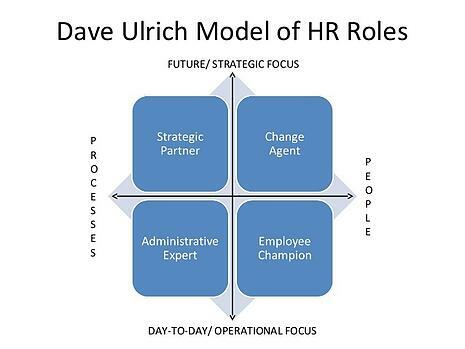
Figure 1 shows that HR is an integral part of human resources management, ensuring its successful functioning, and it plays one of the critical HR roles. For structural changes, Ulrich proposed to divide necessary human resources operations between three primary organisational services (Harrop, 2017). This approach is widely known as the three-legged stool model. Ulrich’s three-legged stool of human resources management rests on three pillars: strategic partners (solve strategic tasks), a centre of expertise (have technical knowledge and skills) and a shared services centre (solve various operational tasks) (Harrop, 2017). In turn, business partners who use this model have four roles to play: strategic partner, change agent, employee advocate and HR process administration expert.
The HR specialist roles envisaged by Ulrich’s concept cover both the entire traditional range of business and employment support activities of the HR specialist, as well as the fundamentally important strategic aspect of HR and the principles of initiative and innovation repeatedly mentioned as an additional source of effective HR (Harrop, 2017). From business practice, the main advantage of the “HR – business partner” model in the sophisticated approach is the unification of all areas of HR-department work into a single mechanism correlated with the organisation’s strategy and working to improve its effectiveness.
Regarding the business model of the author
The oil and gas distribution industry is a satisfying large business. As a rule, the companies working in this sphere, have the prominent organisational structure, it also concerns that company on which example the current analysis is carried out. The mentioned company has its HR-department, which performs classical functions for HRM. This is a rather complex model, requiring careful preparation for all the links in the business. To implement it, the author’s business concept requires the presence of several roles in HRM, which is complicated by the small size of the enterprise.
Harvard Model
Specialists developed the 4C model as a means of investigating HRM issues in a broader business environment rather than using the generally accepted objectives of recruitment, selection, training, certification and personnel records management. According to the Harvard scheme, HRM policy should be based on an analysis of stakeholder needs and several contextual factors, as depicted on Figure 2. This theory assumes that since an organisation is owned and operated by different stakeholder groups, the objective of management is to achieve a reasonable balance between the interests of those groups. An example of stakeholders would be shareholders, different categories of employees, customers and users of products, creditors (including banks), trade unions and possibly local or state authorities.
Situation factors include labour market conditions, employee morale and motivation, a management style that itself depends partly on the culture of the local community and the technologies and methods used in production. Labour market conditions are critical for the analysis. The labour market brings together all those who are looking for work and all companies that are in search of workers. Labour markets operate at the regional, industry, national and international levels. There are also sub-markets for different categories of employment, qualifications and educational levels.
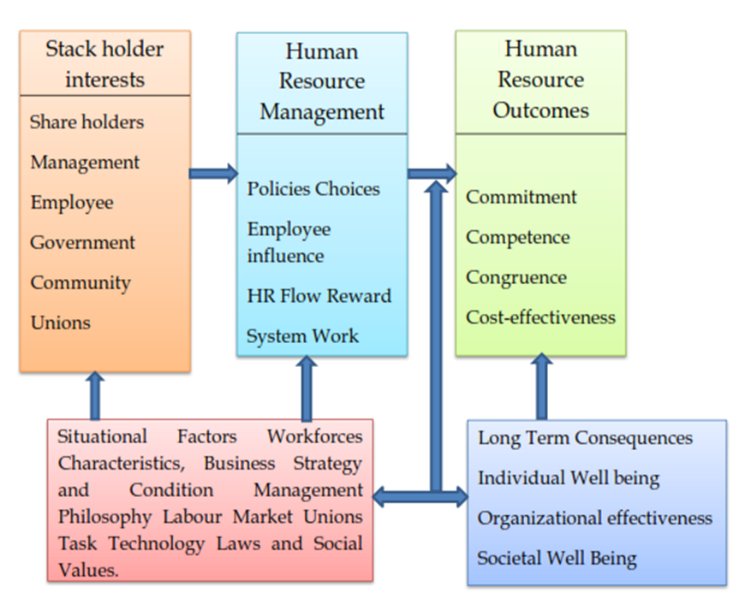
Stakeholder expectations and situational factors should be considered when developing a human resources strategy. They should influence HRM policies to address issues such as the remuneration system, the degree of supervision of workers and the preference for employment-intensive over capital-intensive work methods. The growing intensity of competition in business may force a company to increase productivity, resort to redundant dismissals or restructure the administrative system.
Regarding the business model of the author
For small businesses, this model seems technically challenging to implement because it requires the use of many resources. Company managers must have the qualities of politicians and diplomats: they must be able to establish good relations with each group of stakeholders and develop the ability to persuade, create alliances and represent one part of stakeholders to another. There is a wide variety of variables potentially suitable for almost any human resource situation. It is often simply impossible to identify the key factors that determine the true nature of a human resource situation.
Michigan Model
One of the first statements about the HRM concept was made by the Michigan School, which believed that HR systems and organisational structure should be managed in a way that is consistent with the organisational strategy. The described model was called the “HR compliance model”, within the framework of which the concept of human resources cycle was given. The Fombrand model, which consists of four main processes or functions performed in any organisation, includes selection, certification, reward and development, which is shown in Figure 3. First, selection involves matching human resources available to jobs.
Secondly, certification is defined as the management of the performance of a company. Third, remuneration is used to incentivise organisational performance; it is essential to note that it encourages both short-term and long-term achievement, bearing in mind that the enterprise must operate well today to succeed in the future. Finally, development is responsible for the professional development of employees and the improvement of their skills and competencies.
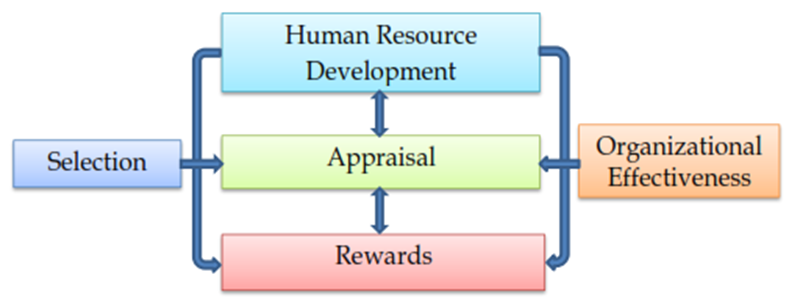
Regarding the business model of the author
This model seems to be suitable for application to the author’s model, since it covers most HR functions and roles, while not requiring many resources.
Warwick Model
This human resource management model is a modified continuation of the Harvard model. The basic idea behind this model is to divide the role of HRM into five components: external context, internal context, business strategy content itself, HRM context and HRM content. The explanation of how certain factors may affect the business is fundamental to this model. Figure 4 depicts that Warwick model is the most comprehensive and shows the relationship between the different components of HR and business strategy.
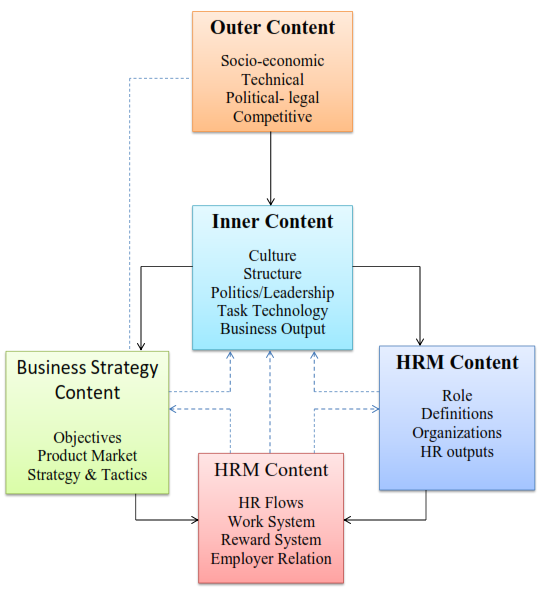
Regarding the business model of the author
This model, although seemingly complex at first sight, may be suitable for the author’s business strategy, as it fully reflects all kinds of business development scenarios.
As a rule, companies combine different ways of obtaining HR-analysts: they conduct internal researches independently or with the involvement of a contractor, use publicly available information on the labour market (mass media, Internet, professional conferences) and official data of research companies and state services.
Business Environment Analysis Tools
Business analysts often use various tools in their work to determine the economic profitability and effectiveness of the business model. The strategic analysis is defined as the way of processing the information on the internal and external environment of the company, level of its development and weaknesses and strengths. The purpose of such analysis is the development of an effective strategy of the management of the enterprise. Tools used to achieve this goal may include SWOT analysis, PEST analysis, Boston Matrix, Sigma analysis and others. The Table 2 shows a comparison of the two most popular types of strategic tools: SWOT analysis and PEST analysis.
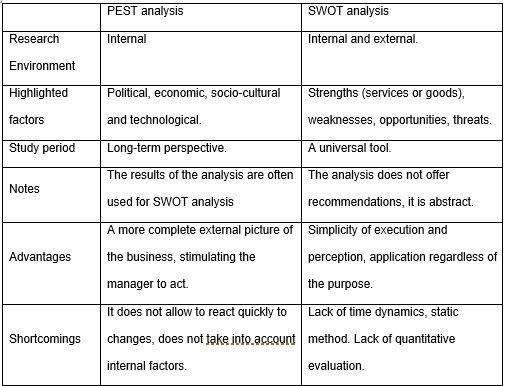
The analysis of this table shows the fundamental difference between the two instruments. Despite the greater complexity of execution, PEST is a more accurate analysis method. Also, SWOT analysis is often based on the data obtained during PEST. SWOT analysis, in turn, has a wide range of the business picture covered. PEST focuses on external environmental factors that affect the business, while SWOT analysis focuses on internal and external factors. PEST explores the political and legal environment, looking at employment laws, political issues, taxes and regulations that affect the business.
Stages of Strategy Development
The process of designing and planning the future of the company is closely connected with the use of various organisational tools. To develop a strategy for HRM, it is necessary to clearly understand the level at which the company is now, where it is moving and what actions are being taken to run the company to the desired level. For these purposes, there is a system of five-step analysis, including analysis, formulation, evaluation, implementation and monitoring. A more detailed analysis of each stage provides insight into how a particular resource will be used.
Analysis
At the first stage of development, the current situation within the company is analysed. It can be said that analysis is about collecting a lot of useful information that could potentially help the development of the company. HR-strategy should be based on a qualitative assessment of the enterprise organisation (Uhl and Gollenia, 2016). HRM’s role at this stage is to identify factors that may, in a positive or negative context, affect the achievement of the objective. The SWOT or PEST analysis can be used for the assessment, aimed at identifying strengths, weaknesses, risks and opportunities. Moreover, strategy makers should focus on the disadvantages and benefits of the enterprise personnel, with attention to their potential.
Formulation
The transition from a discussion of the current situation to the prospects that await the company is underway at this stage. The organisation’s mission must be appropriately designed to build a path to the goal in the subsequent steps. The HR department plays a vital role as it carries out educational work with employees aimed at demonstrating the new strategy of the company. It is possible to create a register of the most critical issues in terms of their priority, and then try to answer the question of what will happen if they cannot be solved. It should be remembered that not only the HR-department decides about what course of development the company should choose, but also its superiors.
Evaluation
The work that has already been done as part of the development of the company’s strategy must, at some point, be evaluated for effectiveness. At this stage, a secondary analysis of materials is being carried out. HR is involved in the assessment through the creation of a form of measurement, which allows the assessment procedure itself. At this stage, a risk assessment is also performed, as the proposed solutions should not lead to the company collapse.
Implementation
The most formal and standardised stage is this one. In fact, it is the use of data obtained during the previous three steps. Emerging issues and new challenges need to be corrected; HRM’s task is to monitor changes. To do this, a Force-field analysis method is generally used to prioritise issues that arise. Finally, for all problems, options should be proposed for the management team. It is imperative that professionals do not dwell on outdated methods of work, but try to find something new, getting rid of all stereotypes.
Control
The last step is to monitor the implementation of all available plans and to assess the performance of the human resources department continuously. The final goal of the development is that all the planned goals can be fulfilled on time, and there are no contradictions between them. This is one of the most critical stages, as it can be used to predict whether a development strategy created will lead to success or not.
The HR department at the last stage helps to make a quantitative and qualitative assessment of changes, based on which decisions on implementation of such strategies will be later built. Furthermore, the HR strategy should be formed in such a way that all functions performed by the HR department are relevant and harmoniously complement each other. For example, bonus and payroll systems can be combined with employee training and further professional development. There will be no benefit from training if it later becomes clear that the company cannot help its employees to achieve harmonious development in personal and professional terms.
HR’s Contribution to the Company’s Business Corporate Ethics
It is known that many different complexities can lead to unwanted behaviour in business. Companies and personnel are currently facing a range of challenges that create an environment conducive to ethical dilemmas and conflict. It is appropriate to note that the sources of such problems may be the existing economic difficulties, motivating a person to achieve excellent results in any way.
All this in one way or another creates an environment in which several social issues related to business and corporate ethics are manifested. These include artificially creating inequality among partners, attempts to reduce competition and difficulties associated with trying to meet the demands of many shareholders, including in terms of performance. In such conditions of doing business, ethical problems quickly arise.
Business Ethics Development as an HRM Function
HR-manager in terms of formation and maintenance of corporate ethics within the enterprise at different stages can contribute to the formation of the ethical corporate culture. This is done by hiring personnel who will subsequently set the ethical tone in the organisation, as well as maintain an ethical climate and corresponding values.
Besides, it is essential to understand that HR-specialists do not finish their work in search of new employees, but continue to lead employees on their professional way, resolving all kinds of ethical conflicts and working with their consequences. It is also interesting to note the formation of D&I policy, which is directly related to the HR-department work. A modern business company needs to meet current trends, that is why by applying the principles of diversity and involvement among employees, HR not only form the necessary social environment but also increase the public rating of the company.
Accountability is one side of the business competence influenced by HRM. Of course, it is not possible to make staff accountable to each other, but it is possible to instil this culture and HR forms the right environment. Reporting on personnel is one of the critical tasks of an HR specialist, and he or she should promote the tendency to be open and honest among employees. To maintain the culture, which values accountability, the HR specialist must be aware of what the company believes in, and they must fully understand their mission. It is HR, as the first person to be confronted by a recruit, who can impose the right values. It is essential to understand that HR is almost the most prestigious department, which has properties to influence all employees and all departments.
Business performance assessment and the role of HR
Enterprise Performance Indicators
Assessment of business performance can be carried out in various ways, most often emphasising financial and non-financial indicators of success. These are complex systems that are divided into sub-sections. The table below shows the factors to which these indicators are divided.
Table 2. Financial and non-financial performance indicators (created by the author).
The above list of non-financial indicators can be continued for quite a long time – everything depends on strategic goals and the resulting direction of the company’s development. Such signs describe personnel work as labour standard, time standard, personnel movement, work satisfaction, workplace safety, and working conditions. Non-financial indicators related to production include marriage parameters, material supply volume, inventory structure, average order size, load and shift rates. A large number of non-financial indicators refer to the description of processes related to equipment downtime and production stoppages. It can also include the percentage of defective products that remain after production.
On a completely different plane lie the financial performance indicators. Comparing the company’s revenue with the market situation and with the receipt of its competitors, one can conclude commercial success and business potential. The second absolute indicator, which can be seen in the profit and loss statement, is the gross income, as well as marginal profit. Gross profit is essential because it allows us to understand what benefits a company derives from selling a unit of production and whether this profit, multiplied by the number of units sold, covers the number of overhead costs. The turnover indicators are designed to show how intensively a company uses its assets and its capital.
Turnover indicators can be calculated for current assets, assets, work in progress. And for each of these indicators, it is possible to monitor and improve the performance of a particular part of the production process. Cost of training is most connected with HR work as it shows expenses of the company on receiving highly competent employees.
Business Planning and HRM
Business planning should assess the possible risks that could accompany change. In addition to financial risks, it is also important to consider human resources (Uhl and Gollenia, 2016). Prevention of personnel risks is based on correct HR-policy of the company, monitoring of compliance with labour legislation, familiarisation of all personnel with the peculiarities of the production process and safety techniques, organisation of professional development of employees and rotation of personnel. The Figure 5 shows which sources form the environment for business planning. HR can be included in a business planning strategy at an early stage.
The function of the department will be to define key performance indicators. With the help of HR metrics, the managers making decisions concerning planning will be able to get better acquainted with the company’s budget. HR performs an analysis of the current labour supply on the labour market, forecasts the demand for workers in the company and provides the best match between employees and workplaces.

Moreover, there is a three-step planning theory, usually using an ice cube as an example. Defrosting is a stage where the manager’s actions are aimed at making people recognise the need for change. The second phase is movement, or the practical implementation of change, which requires careful planning and wise management. The final stage is freezing when new standards of behaviour are set. It is important to note that this phase may require changes to control systems that authorise the use of old models and encourage staff to apply new ones.
Planning for Change and HRM
The modern world is changing very rapidly, and new technologies, new ways of information and communication are appearing daily, the demographic situation is changing, the structure of consumer demand is changing. Some changes give rise to others – and so with increasing speed. On the one hand, some of these changes make it easier to do business, and on the other hand, some of these changes make it more complicated so, if the company-manufacturer can have problems if the competitor has changed in technologies that can accelerate business processes.
When introducing changes, the assessment of business efficiency is of great importance. In case the change is implemented, HR-department and management should analyse how the modified business model is applied not only to the company’s position in the external market, but also in the internal environment. Close interaction with business is the most important task of HR at any time, but in the period of changes, its role as a business partner – adviser becomes most actual (Uhl and Gollenia, 2016). The functions of HR in such a case are to initiate changes, help managers to implement them, communicate with staff and monitor people’s attitude to changes, as well as to retain critical employees.
A vivid example of integration of change management and planning functions in business is the theory of change agents at Yahoo. The HRM implementation strategy to facilitate the transfer of changes by the company and employees is non-standard: Yahoo recruits people who serve as “change agents”, i.e. those who stimulate change, coordinate changes in processes and systems. Typically, these employees are outsiders and are outside the management vertical within the company, but the change agent is the employee.
The second example, connected with the introduction of HR-department in business planning of the organisation, is company IBM, one of the first who has created a post of the manager on work with people. Such managers were not managers in the typical sense but instead allowed the strategic department of the company to interact more actively with employees when planning future changes in business processes. An essential function of the HR department for business planning is the retraining of personnel to obtain new competencies, which is included in the further development program.
Impact of External and Internal Data Sources
Table 3. Examples of external and internal sources for planning and their impact on the company (created by the author).
It is wrong to assume that any sources of business and context information, regardless of their type, have a positive impact on the development of the company. Using the above table, it can be noted that each such source can have both positive and negative impact. HRM’s function here is to balance the extremes and choose a path that does not bring risks to the company.
Internal sources, such as the accounting system, have great potential for making decisions about planning and change management. The system allows us to see the financial policy of the company in a cross-section, but the system requires careful analysis, as incorrectly presented information can negatively affect the development of the organisation. HR can conduct internal surveys of employees who will also provide useful subjective data about the company.
However, such opinion polls are rarely objective and require in-depth analysis. Besides, they require a significant investment of resources. The same applies to external sources of information: analysis of the oil and gas market price policy helps a company create its competitive strategy. However, the cost of services is often subject to dramatic changes due to, for example, the economic crisis in a country or currency depreciation. Assessing regulatory parameters is more difficult for international business as it requires knowledge of the laws and regulations of other states. However, predicting possible changes at the state level can improve a company’s success rate.
Reference List
Collings, D.G., Wood, G.T. and Szamosi, L.T. (eds) (2018) Human resource management: a critical approach. 2nd edn. Abingdon: Routledge.
Harrop, J.J. (2017) ‘Assessment and recommendations for effective HR service delivery model implementation for organizations’, Middle East Journal of Business, 55(4022), pp.1-5. Web.
Shingal, T. (2019) ‘Managing HR roles: David Ulrich’s HR model’. MettlBlog.
Uhl, A. and Gollenia, L.A. (2016) A handbook of business transformation management methodology. Abingdon: Routledge.